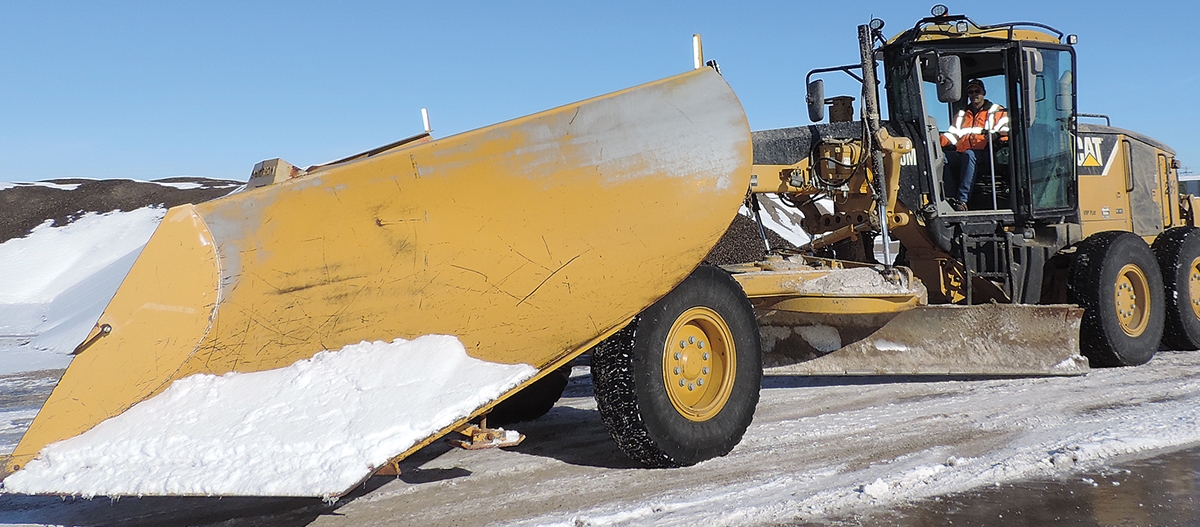February is the favorite month for snowplow drivers of Minidoka County.
“It’s about the halfway point for our plowing season,” said Del Maier, 59, who began working for the Minidoka County Road Department in 1990. “That’s when we start our countdown to the end of winter.”
For decades, he and another veteran driver, Scott Mecham, 55, who was hired in 1992, have been coping with their sometimes mundane, occasionally futile and often fatiguing, frightening, yet ultimately fulfilling jobs with a sense of humor and dedication.
The stress is tempered with the satisfaction of providing a vital public service for commuters and emergency responders in remote areas of southeastern Idaho. At times, they are asked to plow and lead the way for ambulance and school bus drivers or linemen who need to fix a power outage.
Based in Rupert, they are among the 18 department employees who keep about 300 miles of paved and 300 miles of gravel roads clear of snow from late fall to early spring. They navigate a fleet of six graders and seven trucks equipped with massive plows.
“During storms, everyone in our department works hard and for as long as we’re needed. We’re a team, and the office staff does an awesome job, too. We keep each other going,” said Maier. “One time, I worked 21 hours straight. Your eyes hurt from the strain of trying to see where you’re going.”
Between storms, Maier and Mecham take a break from doing maintenance on their equipment to recall their most harrowing and humorous experiences.
While plowing snow up a steep hill one dark morning, Maier said he suddenly felt his 22-ton road grader start to slide backwards next to the cemetery north of Rupert. He desperately tried to steer.
“To get some control, I shifted to reverse faster than I’d ever done before,” he said.
When he finally stopped sliding at the bottom of Cemetery Hill, he put chains on the tires to gain traction.
“I could hardly see,” he said. “It was 4 a.m., and the wind was blowing snow everywhere. That was back in the mid-90s before we had radial tires. The radials we use now have good traction, so we don’t need to chain up most of the time.”
Maier still carries chains on the side of his grader but uses them mostly to rescue drivers and pull their vehicles—school buses, semi-trucks, and cars—back onto the road.
People often ask them to predict what the winter will be like.
“I tell them to look out their window every day just like I do,” Mecham said. “We can only predict and deal with one day at a time.”
Mecham, who is assigned to the remote roads northwest of Paul, recalled joking with a motorist after he pulled his car back onto the road.
“He asked me how I could even see,” Mecham said. “I happened to be wearing sunglasses and asked him if he hadn’t heard about the magic glasses. He said he hadn’t, so I laughed and told him I hadn’t either, because I couldn’t see the road any better than he could.”
Sometimes without warning, the sky and ground blend together in a wall of white while they are driving.
“When visibility is almost zero, you use landmarks like weeds growing alongside the road or utility poles, so you know where to drive,” Maier said. “In some remote places, though, there aren’t poles. All of a sudden you see stubble and realize you’re plowing snow on a farmer’s field. When it’s foggy, you can’t even see the front of the grader.”
Their cab is warm as a summer day when the heater and defroster blow.
“We keep the windshield warm, so snow and ice will melt as it blows back from the plow, and we can see where we’re going,” Maier said. “It also helps prevent ice balls from forming on the wipers.”
Many days, their efforts seem futile.
“You clear some roads, and by the time you drive back, it’s blown in, so you can’t even tell you plowed,” Maier said.
Progress is slow, too, on some days. During one storm, he drove only three miles in 5 1/2 hours. Some 10-foot-tall snowdrifts have seemed impenetrable.
“You wouldn’t believe how the wind compacts and hardens the snow,” Maier said. “You get a running start and hit a drift hard, and it stops the grader. You try again and might only go 20 feet at a time.”
Maier and Mecham laughed about people thinking they are invincible and never get stuck.
“When I started, my supervisor told me if I didn’t get stuck, I wasn’t plowing enough,” Mecham said.
One farmer watched Maier maneuver his grader back on the road after it slid off.
“He told me he would never have believed what I’d done if he hadn’t seen it,” Maier said. “You can use the blade under the grader to lift it up and push yourself back up on the road. You can only go 1 or 2 feet at a time, so it takes 10 to 15 minutes. Sometimes, you’re almost there, then you slide back off the road and have to start over.”
Maier’s and Mecham’s frustrations are sometimes soothed with kindness.
“We appreciate it when some people wave us down at the edge of the road and give us a plate of homemade cookies or cinnamon rolls,” Maier said.
Whatever happens, Mecham said they are prepared.
“When spring comes, we’ll start fixing the damage from winter—but at least then we can see what we’re doing,” he said. ISI












